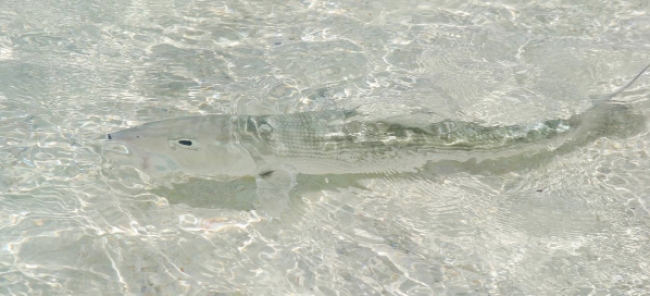Fish can sometimes be difficult to spot with the naked eye, and this is especially true for bonefish. They have impeccable camouflage, and their silver bodies act as mirrors for blending well into their surroundings. This is why they are often referred to as, “the Grey Ghost of the Flats”.There are three primary ways to spot a bonefish and by knowing what to look for, it will make it easier to catch them in their natural environment. Before you fish, be sure to have a good pair of polarized sunglasses; rose or vermillion lenses for normal conditions and amber for low light conditions.
The three primary ways to spot a bonefish are pushing, tailing, and cruising:
Tailing
Finding “tailing” fish is typically the easiest and most exciting means of spotting bonefish. As bonefish feed, they tip their head down to seek out prey on the bottom. When the bonefish are in shallow water as they “work” a flat, this causes their tail to emerge from the surface of the water making them extremely easy to spot. Approach cautiously, then present the fly close to their direction of travel.
Pushing
One way to spot bonefish as they swim just below the surface of the water; is by looking for the wake or ripples they create, which is known as a “push.” The “push” of a large school of bonefish, or even a single fish cruising in shallow water can be quite dramatic. Sometimes fish may be feeding or moving slowly along the bottom, and just barely disturbing the surface of the water. This is commonly referred to as “nervous water”, and is easily identifiable if the surrounding water is calm. Pushes can be more difficult to identify with windier conditions. Keep your eye on areas that seem highly active, even if you can not spot any fish right away.
Cruising
Lastly, you can spot bonefish by looking for those that are “cruising” the flats. This can sometimes be challenging due their ability to change their coloration to camouflage their presence, adapting to the hues of the waters in which they reside.
Bonefish are like chameleons and their backs take on the coloration of their surroundings. Thus, fish that spend time over a very dark bottom such as rocks or turtle grass will have a very dark back (top) to blend into their background. As these bonefish are swimming over the flats they will be difficult to spot until they go over a light or sandy area and then they become quickly and easily recognizable. Even more difficult to spot are those bonefish which reside over the light sandy beach flats. Those fish take on the very light coloration of their surroundings and become almost transparent. These fish are sometimes only spotted by an experienced guide.
Catching bonefish that are cruising tends to be difficult mainly because this is a time when they are highly alert and not eating as much. They are generally moving between feeding spots.Always throw your fly well ahead of the cruising fish so the fly has time to settle to the bottom before it is reached. If the fly lands too close, the fish might spook and leave the area. Another challenging of casting to cruising fish is their erratic pattern of movement. Unlike some sight fishing targets, such as tarpon which move generally in a straight line, bonefish change directions often, making it difficult to anticipate exactly where a bonefish’s path will intersect with your fly. Allowing the fly to sink to the bottom, then creating movement when the bonefish pass nearby will allow you to attract the attention of the fish, even though they may have altered their cruising path.
These three ways of spotting bonefish take time and patience to master. The more days on the flats the better your spotting ability will become. Remember to keep your back to the wind, the sun is your friend and to always, always trust your guide.








